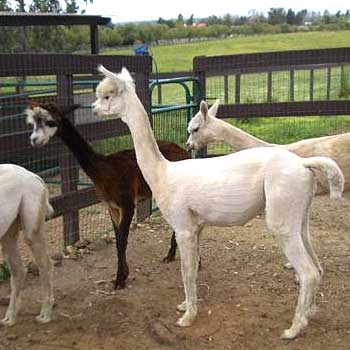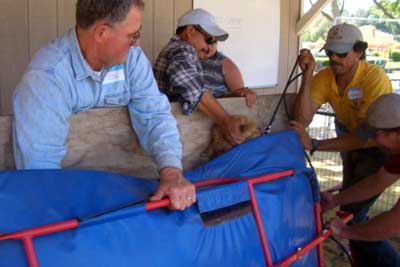| |
Alpaca fleece is as prized today as it was when the animals were
first domesticated 6,000 years ago. Huacaya fleece is dense and crimpy,
and the suri alpaca has silky fleece that grow in long spirals.
Springtime is shearing season. Much like a barn raising or a quilting
bee, shearing day is a time for teamwork and sharing. Some ranches shear
their own animals, others hire a traveling expert. The key is to do it
as quickly and efficiently as possible so there is minimal stress on
the alpacas since most of them are pregnant females! |
|
 Shearing
Day is an opportunity for several other details
to be taken care of while working with the animals: weighing, body-scoring,
toe-nail clipping, vaccinations, and new nametags. Records are carefully
checked so that females are not shorn within 60 days of either being
newly pregnant or delivering. A secondary shearing time is planned for
these girls. Shearing
Day is an opportunity for several other details
to be taken care of while working with the animals: weighing, body-scoring,
toe-nail clipping, vaccinations, and new nametags. Records are carefully
checked so that females are not shorn within 60 days of either being
newly pregnant or delivering. A secondary shearing time is planned for
these girls.
Most animals are frightened by the noise
and the process, a few are spitty. A mild sedative or Rescue Remedy
administered in the waiting pen 15 minutes before shearing soothes
both the alpaca and the handlers. And disposable socks tucked over the
nose of spitters keeps it to themselves.
Vacuuming or blowing each alpaca just before shearing clears out the
dirt and sand they have rolled in, and extends the life of the shearer's
blades.

Shearing on the Ground
 |
 |
Front and hind feet are constrained by ropes anchored
on a pivot. One person holds the animal's head at all times. The
shearer begins at the lower belly, moving front to back, and proceeds
up to the spine. The alpaca is rotated as shearing proceeds
down his back and over to the other side of the belly. This 'blanket'
fleece is the prime fleece, and it is gathered into a bag.
 Next, the neck is sheared, then the front legs and the back ones,
rotating the animal over again as necessary. The secondary neck
and leg fleece is gathered into another bag. Next, the neck is sheared, then the front legs and the back ones,
rotating the animal over again as necessary. The secondary neck
and leg fleece is gathered into another bag.
Both bags are marked
with the animal's name, and weighed. Totals are kept for reference
to the previous year's data on each alpaca. This aids in breeding
decisions, pairing a densely-fleeced animal to one less dense
in order to improve the quality of the next generation.
After shearing, the alpacas check each other out,
as if to make certain that these skinny creatures are their same
buddies. |
.

Shearing on a Table
 |
With the shearing table is set vertically, the blue padded
covering opens by a hinge at the rear, and the alpaca is led in
and safely constrained while it is standing. Then the table
is rotated to horizontal position and is locked in place.
|
 |
Restraints are put on the animal's feet, and one person maintains
control of the head all times.
Fleece collectors stand by at the ready,
and as the shearer does his work, they dance around the table,
staying out of his way while collecting every bit of the clippings.
|
 |
If a fleece sample is taken for micron testing, a 2-inch square
is shorn from the midpoint of the alpaca's side. The sample is
bagged and labeled separately.
The shearer begins cutting the blanket fleece along the lower
edge, moving along toward the spine in long motions from base of
the neck to the rear legs.
|
 |
Because of the crimpy fiber, the huacaya's blanket fleece holds
together and rolls off in a wave. If it is intended as a 'show
fleece' it is carefully collected and bagged, maintaining the integrity
of the blanket as a whole piece.
If not a show fleece, the blanket is placed in a plastic bag and
left loosely closed so it can 'breathe.'
|
 |
Next, the legs and neck are sheared and this secondary fleece
is placed in another marked bag. Both bags are weighed and recorded.
|
 |
Once shearing is complete, the padded restraint is lowered onto
the animal, the ropes are removed from its feet, and the table
is tilted vertically once more.
|
 |
Voila! a freshly sheared alpaca, eager for her getaway.
Spa day is over at last! |

Shearing a Llama
 |
 |
Llamas are too large to be put on the shearing
table or handled on the ground, so they are sheared while standing.
The lead rope is securely tied, and one or two other helpers are
available for restraint as necessary. Quigley was especially patient,
no doubt pleased to shed his heavy coat.
Thank you to Alpacas of Cusco North, Canzelle
Alpacas, and Alpacas
de Los Olivos, our 'hosts' for these shearing photos. |
Now, what are we going to do with all of those bags of fleece??!
To market, to Market...
|

